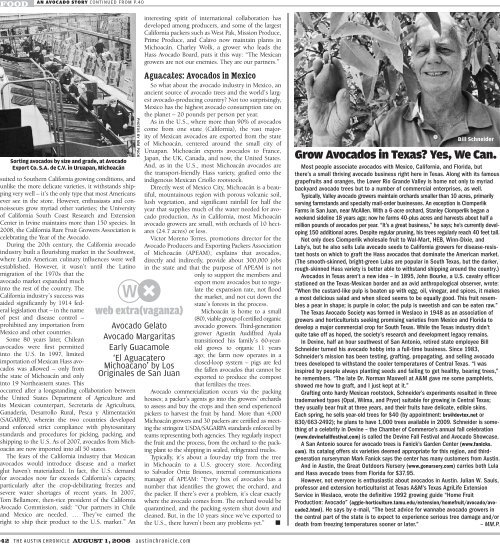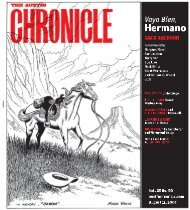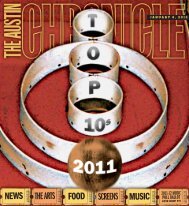Create successful ePaper yourself
Turn your PDF publications into a flip-book with our unique Google optimized e-Paper software.
FOODAN AVOCADO STORY CONTINUED FROM P.40Sorting avocados by size and grade, at AvocadoExport Co. S.A. de C.V. in Uruapan, Michoacánsuited to Southern California growing conditions, andunlike the more delicate varieties, it withstands shippingvery well – it’s the only type that most Americansever see in the store. However, enthusiasts and connoisseursgrow myriad other varieties; the Universityof Cali for nia South Coast Research and ExtensionCenter in Irvine maintains more than 150 species. In<strong>2008</strong>, the California Rare Fruit Growers Association iscelebrating the Year of the Avocado.During the 20th century, the California avocadoindustry built a flourishing market in the Southwest,where Latin American culinary influences were wellestablished. However, it wasn’t until the Latinomigration of the 1970s that theavocado market expanded muchinto the rest of the country. <strong>The</strong>California industry’s success wasaided significantly by 1914 federallegislation that – in the nameof pest and disease control –prohibited any importation fromMexico and other countries.Some 80 years later, Chileanavocados were first permittedinto the U.S. In 1997, limitedimportation of Mexican Hass avocadoswas allowed – only fromthe state of Michoacán and onlyinto 19 Northeastern states. Thisoccurred after a longstanding collaboration betweenthe United States Department of Agriculture andits Mexican counterpart, Secretaría de Agricultura,Ganadería, Desarrollo Rural, Pesca y Alimentación(SAGARPA), wherein the two countries developedand enforced strict compliance with phytosanitarystandards and procedures for picking, packing, andshipping to the U.S. As of 2007, avocados from Michoa cán are now imported into all 50 states.<strong>The</strong> fears of the California industry that Mexi canavocados would introduce disease and a marketglut haven’t materialized. In fact, the U.S. demandfor avocados now far exceeds California’s capacity,particularly after the crop-debilitating freezes andsevere water shortages of recent years. In 2007,Tom Bellamore, then-vice president of the CaliforniaAvocado Commission, said: “Our partners in Chileand Mexico are needed. … <strong>The</strong>y’ve earned theright to ship their product to the U.S. market.” AnPHOTOS BY MM PACKweb extra(vaganza)Avocado GelatoAvocado MargaritasEarly Guacamole‘El AguacateroMichoacano’ by LosOriginales de San Juaninteresting spirit of international collaboration hasdeveloped among producers, and some of the largestCalifornia packers such as West Pak, Mission Produce,Prime Produce, and Calavo now maintain plants inMichoacán. Charley Wolk, a grower who leads theHass Avocado Board, puts it this way: “<strong>The</strong> Mexicangrowers are not our enemies. <strong>The</strong>y are our partners.”Aguacates: Avocados in MexicoSo what about the avocado industry in Mexico, anancient source of avocado trees and the world’s largestavocado-producing country? Not too surprisingly,Mexico has the highest avocado consumption rate onthe planet – 20 pounds per person per year.As in the U.S., where more than 90% of avocadoscome from one state (California), the vast majorityof Mexican avocados are exported from the stateof Michoacán, centered around the small city ofUruapan. Michoacán exports avocados to France,Japan, the UK, Canada, and now, the United States.And, as in the U.S., most Michoacán avocados arethe transport-friendly Hass variety, grafted onto theindigenous Mexican Criollo rootstock.Directly west of Mexico City, Michoacán is a beautiful,mountainous region with porous volcanic soil,lush vegetation, and significant rainfall for half theyear that supplies much of the water needed for avocadoproduction. As in California, most Michoacánavocado growers are small, with orchards of 10 hectares(24.7 acres) or less.Victor Moreno Torres, promotions director for theAvocado Producers and Exporting Pack ers Associationof Michoacán (APEAM), explains that avocados,directly and indirectly, provide about 300,000 jobsin the state and that the purpose of APEAM is notonly to support the members andexport more avocados but to regulatethe expansion rate, not floodthe market, and not cut down thestate’s forests in the process.Michoacán is home to a small(80), viable group of certified organicavocado growers. Third-generationgrower Agustín Audiffred Ayalatransitioned his family’s 60-yearoldgroves to organic 11 yearsago; the farm now operates in aclosed-loop system – pigs are fedthe fallen avocados that cannot beexported to produce the compostthat fertilizes the trees.Avocado commercialization occurs via the packinghouses; a packer’s agents go into the growers’ orchardsto assess and buy the crops and then send experiencedpickers to harvest the fruit by hand. More than 4,000Michoacán growers and 30 packers are certified as meetingthe stringent USDA/SAGARPA standards enforced byteams representing both agencies. <strong>The</strong>y regularly inspectthe fruit and the process, from the orchard to the packingplant to the shipping in sealed, refrigerated trucks.Typically, it’s about a four-day trip from the treein Michoacán to a U.S. grocery store. Accordingto Salvador Ortiz Briones, internal communicationsmanager of APEAM: “Every box of avocados has anumber that identifies the grower, the orchard, andthe packer. If there’s ever a problem, it’s clear exactlywhere the avocado comes from. <strong>The</strong> orchard would bequarantined, and the packing system shut down andcleaned. But, in the 10 years since we’ve exported tothe U.S., there haven’t been any problems yet.” Bill SchneiderGrow Avocados in Texas? Yes, We Can.Most people associate avocados with Mexico, California, and Florida, butthere’s a small thriving avocado business right here in Texas. Along with its famousgrapefruits and oranges, the Lower Rio Grande Valley is home not only to myriadbackyard avocado trees but to a number of commercial enterprises, as well.Typically, Valley avocado growers maintain orchards smaller than 10 acres, primarilyserving farmstands and specialty mail-order businesses. An exception is CiomperlikFarms in San Juan, near McAllen. With a 6-acre orchard, Stanley Ciomperlik began aweekend sideline 18 years ago; now he farms 40-plus acres and harvests about half amillion pounds of avocados per year. “It’s a great business,” he says; he’s currently developing150 additional acres. Despite regular pruning, his trees regularly reach 40 feet tall.Not only does Ciomperlik wholesale fruit to Wal-Mart, HEB, Winn-Dixie, andLuby’s, but he also sells Lula avocado seeds to California growers for disease-resistanthosts on which to graft the Hass avocados that dominate the American market.(<strong>The</strong> smooth-skinned, bright-green Lulas are popular in South Texas, but the darker,rough-skinned Hass variety is better able to withstand shipping around the country.)Avocados in Texas aren’t a new idea – in 1895, John Bourke, a U.S. cavalry officerstationed on the Texas-Mexican border and an avid anthropological observer, wrote:“When the custard-like pulp is beaten up with egg, oil, vinegar, and spices, it makesa most delicious salad and when sliced seems to be equally good. This fruit resemblesa pear in shape; is purple in color; the pulp is sweetish and can be eaten raw.”<strong>The</strong> Texas Avocado Society was formed in Weslaco in 1948 as an association ofgrowers and horticulturists seeking promising varieties from Mexico and Florida todevelop a major commercial crop for South Texas. While the Texas industry didn’tquite take off as hoped, the soci ety’s research and development legacy remains.In Devine, half an hour southwest of San Anton io, retired state employee BillSchneider turned his avocado hobby into a full-time business. Since 1983,Schneider’s mission has been testing, grafting, propagating, and selling avocadotrees developed to withstand the cooler temperatures of Central Texas. “I wasinspired by people always planting seeds and failing to get healthy, bearing trees,”he remembers. “<strong>The</strong> late Dr. Nor man Maxwell at A&M gave me some pamphlets,showed me how to graft, and I just kept at it.”Grafting onto hardy Mexican rootstock, Schneider’s experiments resulted in threetrademarked types (Opal, Wilma, and Pryor) suitable for growing in Central Texas;they usually bear fruit at three years, and their fruits have delicate, edible skins.Each spring, he sells year-old trees for $40 (by appointment: brs@devtex.net or830/663-2492); he plans to have 1,000 trees available in 2009. Schneider is somethingof a celebrity in Devine – the Chamber of Commerce’s annual fall celebration(www.devinefallfestival.com) is called the Devine Fall Festival and Avocado Showcase.A San Antonio source for avocado trees is Fanick’s Garden Center (www.fanicks.com). Its catalog offers six varieties deemed appropriate for this region, and thirdgenerationnurseryman Mark Fanick says the center has many customers from <strong>Austin</strong>.And in <strong>Austin</strong>, the Great Outdoors Nursery (www.gonursery.com) carries both Lulaand Hass avocado trees from Florida for $37.95.However, not everyone is enthusiastic about avocados in <strong>Austin</strong>. Julian W. Sauls,professor and extension horticulturist at Texas A&M’s Texas AgriLife ExtensionService in Weslaco, wrote the definitive 1992 growing guide “Home FruitProduction: Avocado” (aggie-horticulture.tamu.edu/extension/homefruit/avocado/avocado2.html).He says by e-mail, “<strong>The</strong> best advice for wannabe avocado growers inthe central part of the state is to expect to experience serious tree damage and/ordeath from freezing temperatures sooner or later.”– MM.P.42 T H E A U S T I N C H R O N I C L E AUGUST 1, <strong>2008</strong> a u s t i n c h r o n i c l e . c o m
















